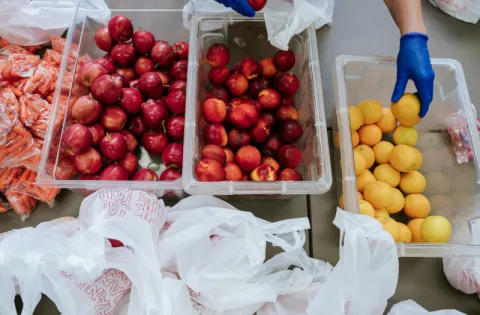A new report released by the National Commission on Hunger, “Freedom from Hunger: An Achievable Goal for the United States of America,” posits a bold but believable assertion that we should and can end hunger in America. This report offers a number of sensible recommendations to address the nation’s hunger crisis. It also provides a refreshing and compelling witness to successful bi-partisanship with representatives from across the political spectrum coming together to learn, discuss, and arrive at consensus.
With unanimous support from Commission members appointed by Republican and Democratic Congressional leadership, the report acknowledges the hunger problem in the U.S., affirms the critical role that the federal nutrition programs play in mitigating hunger, and offers recommendations to strengthen these existing programs by making them more effective and efficient and by testing a number of good ideas. While the report acknowledges that hunger is a product of larger structural problems like poverty, unemployment, and discrimination, the Commission’s charge from Congress was to focus on how to improve the existing federal nutrition programs. Therefore, other important policies that can address poverty, employment, and wages were not considered.
As an organization dedicated to ending childhood hunger in the U.S., Share Our Strength strongly supports a number of recommendations that would dramatically improve the lives of hungry children. For example, the Commission recommends a series of changes to the Supplemental Nutrition Assistance Program (SNAP), formerly called the Food Stamp Program.[i] The report recognizes the critical role that SNAP plays in reducing hunger while recognizing that the program could do more. With 45 million participants, SNAP has the greatest reach among all the existing federal nutrition programs, making it an effective vehicle to reduce hunger. The report specifically recommends a pilot to test an increase in the SNAP benefit level from the Thrifty Food Plan to the Low Cost Food Plan, a more generous benefit. Independent evaluations have shown that increasing SNAP benefit levels significantly reduces hunger, especially among very low food secure households.
The report also includes policy prescriptions that would help connect hungry children to healthy meals during the summer months, a time of great need. Over the course of the school year, almost 22 million children get a free or reduced price lunch at school; however, only 4 million children get meals during the summer months, in large part because the Summer Food Service Program created to replace school meals during the summer months is outdated and difficult to administer. For example, children currently have to come to the meals in a structured, supervised setting and consume them on site. While this model works well for some children, the vast majority of children in need of summer meals do not live near a meal site or cannot access one because of extreme weather or violence in the community. The Commission draws on a number of previously evaluated demonstration projects to recommend additional options for feeding hungry kids during the summer months. It recommends allowing states to offer a summer EBT option where families receive a benefit to use at the grocery store. It also recommends allowing for non-congregate feeding in certain circumstances, so children can bring meals home or meals can be delivered to a child’s home. As Congress takes up the reauthorization of the summer meals programs this year (in the Child Nutrition Reauthorization), these recommendations should be given the highest of priority.
Additionally, the Commission seeks to “ensure that SNAP promotes and supports work.” To be clear, this recommendation seeks to improve on existing systems within SNAP and does not recommend imposing new work requirements on program recipients. With clear connections among work, poverty, and hunger, SNAP functions to promote and support work through existing work requirements and employment and training services. The Commission rightly calls out the need for increased funding for workforce services and other work supports like transportation and child care to support SNAP participants as they seek employment. The current level of funding is not sufficient to provide an adequate level of service. Although the vast majority of SNAP participants are not expected to work (as they are children, seniors, individuals with disabilities) or are already working, the small percent of the SNAP caseload who are unemployed adults need the education, training, and job counseling to gain employment and advance in a career. The report also encourages greater flexibility in the use of these employment and training funds to support specific needs of different populations through subsidized employment, substance abuse and mental health treatment, and services to help prisoners as they re-enter society post-incarceration.
In addition to these specific recommendations tied to SNAP and the Summer Food Service Program, the Commission recognizes the need to provide relief from the administrative burden (for both families and those organizations providing program services) often associated with program implementation and seeks greater coordination among various means-tested nutrition, education, medical, and social service programs. The call to action by the Commission is clear: Congress and the Executive Branch need to identify and implement policies that make it easier for families to access nutrition programs in a way that leads to improvements in health, earnings, and educational attainment. The playing field of federal means tested programs is so vast, adoption of this principle could find many paths. For those focused on hunger, the report affirms the importance of policies such as categorical eligibility in SNAP and direct certification for school meals, while encouraging Congress and USDA to embrace new ideas like simplifying out of school time programs for community organizations.
No language in the report recommends block granting SNAP or any other federal nutrition programs, and for good reason. The federal nutrition programs are set up to be countercyclical; they expand to meet increased need during down times and contract when the economy and the economic profile of Americans improves. Block granting means-tested programs results in states not having adequate resources during tough times, causing low-income individuals and families to lose access to critical anti-poverty programs
The Commission ends its series of recommendations with a call to create a White House Leadership Council to End Hunger which would include participation by both government and non-government representatives. This Council would be charged with developing a plan to end hunger in the United States and evaluate the progress to reaching this important goal. Reminiscent of other inter-agency and multi-sector bodies like the U.S. Interagency Council on Homelessness, the creation of this body would help ensure that the root causes of hunger in America were part of the dialogue and policy prescriptions and that the effort to end hunger in America transcended party and president. As the Commission asserts, we can end hunger in the U.S. But we need a plan. We need accountability. And we need to work together, to go beyond partisan politics, to share our strength, to ensure no child or individual goes hungry in America.
[i] Two USDA studies examined changes in the prevalence of very low food security during periods of increasing and declining SNAP benefits. The percentage of SNAP-recipient households with very low food security declined from 2008 to 2009 following the ARRA-mandated benefit increase, and then very low food security rose in subsequent years as inflation eroded the value of SNAP benefits. The changes in food security were proportionately similar in the two periods, suggesting that the associations reflect a cause-and-effect relationship. Taken together, results of the two studies suggest that increasing the maximum SNAP benefit by 10 percent ($69 per month for a family of four) would reduce the number of SNAP-recipient households with very low food security by about 22 percent.



